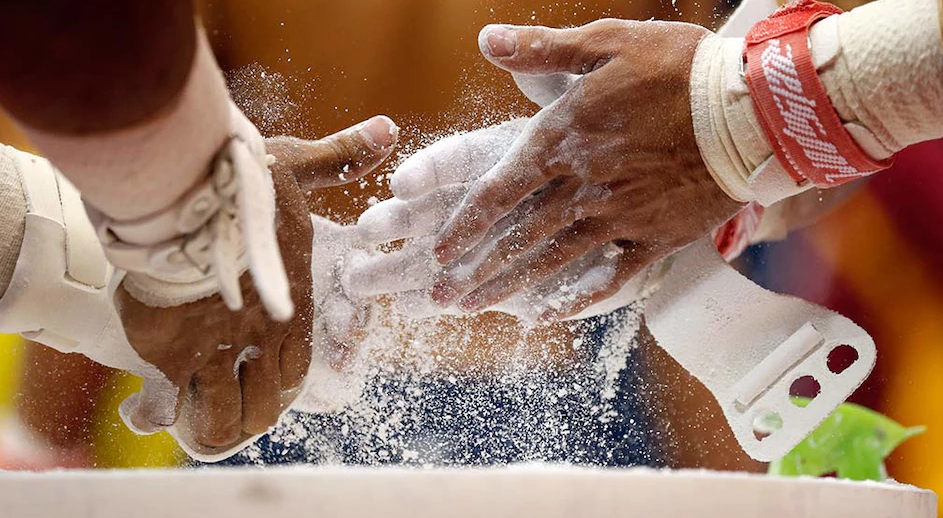Are you searching for how to make gym chalk? This post aims to provide you with all the steps you need to follow when making gym chalk. As you will quickly find out, this is not a complicated process.
Making gym chalk is generally considered to be an easy process that requires just a few materials and tools. The process of making gym chalk is similar to making other types of chalk, such as sidewalk chalk or art chalk.
However, it is important to note that gym chalk is typically made with a specific type of magnesium carbonate called climbing chalk, which is formulated for use in high-moisture environments and is more absorbent than other types of chalk.
What Are The Different Types of Gym Chalk?
There are several types of gym chalk to choose from, including:
- Loose chalk: Loose chalk is a powdery substance that is applied to the hands by dipping them into a bag or container of chalk. It is the most common type of gym chalk and is known for providing a good grip and absorbing moisture well.
- Block chalk: Block chalk is a solid block of chalk that is typically applied to the hands by rubbing it on the skin. It is a more convenient option than loose chalk, as it is less prone to spilling and easier to apply.
- Liquid chalk: Liquid chalk is a liquid form of chalk that is applied to the hands by spraying or rubbing it on the skin. It is a convenient option for those who don’t want to deal with the mess of loose or block chalk. However, it may not provide as much grip or moisture-absorbing properties as other types of chalk.
- Chalk balls: Chalk balls are small, soft balls filled with loose chalk. They are applied to the hands by squeezing the ball and rubbing the chalk onto the skin. Chalk balls are a convenient option that helps to reduce the mess of loose chalk and can be easily stored in a gym bag.
- Chalk socks: Chalk socks are fabric socks filled with loose chalk. They are worn over the hands and feet to provide grip and absorb moisture. Chalk socks are a convenient option for those who don’t want to deal with the mess of loose chalk and can be easily stored in a gym bag.
Gym chalk is a powdery substance used by athletes and weightlifters to help improve their grip and reduce moisture on their hands during training. It is typically made from magnesium carbonate, which is a naturally occurring mineral that is highly absorbent and non-toxic.
Making your own gym chalk at home is a simple process that requires just a few materials and tools.
Steps To Make Gym Chalk
Here are the simple steps you should follow when making gym chalk:
- Gather materials: You will need the following materials to make gym chalk:
Magnesium carbonate (also called magnesium carbonate powder or climbing chalk)
Water
Measuring cups and spoons
Mixing bowl
Whisk or fork
Baking tray
Parchment paper - Mix the chalk: In a mixing bowl, combine 1 cup of magnesium carbonate with 2 tablespoons of water. Use a whisk or fork to mix the ingredients together until a smooth paste is formed.
- Pour the mixture onto the tray: Place a sheet of parchment paper on a baking tray and pour the chalk mixture onto the paper. Use a spatula to spread the mixture out evenly on the tray.
- Dry the chalk: Place the tray in a well-ventilated area and allow the chalk to dry for 24-48 hours. The chalk is ready to use when it is completely dry and no longer feels moist or sticky.
- Break the chalk into chunks: Once the chalk is dry, use your hands or a knife to break it into smaller chunks. You can also use a rolling pin or another tool to crush the chalk into a fine powder if desired.
Factors To Consider When Buying The Best Gym Chalk
There are several factors to consider when buying gym chalk:
- Type of chalk: There are several types of gym chalk to choose from, including loose chalk, block chalk, and liquid chalk. Consider which type of chalk is best for your needs and preferences.
- Quality: Look for gym chalk that is made of high-quality materials and is built to last. Poor-quality chalk may not provide the grip and moisture-absorbing properties you need.
- Absorbency: Choose gym chalk that is highly absorbent to help reduce moisture on your hands and improve your grip.
- Consistency: Consider the consistency of the gym chalk. Loose chalk may be more prone to spilling, while block chalk may be harder to apply. Liquid chalk may be more convenient to use but may not provide as much grip as loose or block chalk.
- Price: Determine your budget and look for gym chalk that offers a good value for the price. Keep in mind that gym chalk can vary greatly in price, so be prepared to spend more for a higher-quality product.
Conclusion
Making your own gym chalk is a simple process that can save you money and allow you to customize the consistency of the chalk to your preference.
By following these steps, you can create your own gym chalk and use it to improve your grip and reduce moisture on your hands during your workouts. Just be sure to store the chalk in a dry place to prevent it from becoming moist or clumping together. You can also learn How to clean NoBull Shoes.
Overall, making gym chalk is a relatively simple process that can be done at home with minimal effort. Just be sure to follow the instructions carefully and use high-quality ingredients to ensure the best results.

